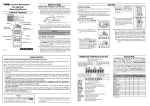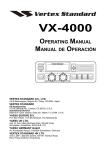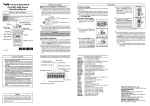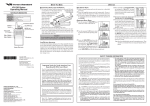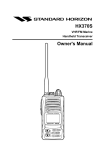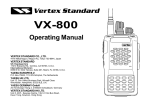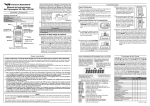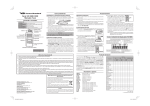Download VX-210A Operating Manual
Transcript
Before You Begin Battery Pack Installation and Removal VX-210A Operating Manual r To install the battery, hold the transceiver with your left hand, so your palm is over the speaker and your thumb is on the top of the belt clip. Insert the battery pack into the battery compartment on the back of the radio while tilting the Belt Clip outward, then close the Battery Pack Latch until it locks in place with a “Click.” Controls & Connectors LED Indicator Glows Green Blinking Green Glows Red Blinking Red Blinking Yellow ACC on Busy Channel (or SQL off) Transmitting Battery Voltage is low Receiving a Selective Call CH (Channel) Selector Antenna VOL/PWR Knob Push To Talk (PTT) Switch MIC/SP Jack (External Mic/Earphone) r To remove the battery, turn the radio off and remove any protective cases. Open the Battery Pack latch on the bottom of the radio, then slide the battery downward and out from the radio while holding the Belt Clip. Speaker Do not attempt to open any of the rechargeable Ni-Cd packs, as they could explode if accidentally short-circuited. Caution! ACC Button Low Battery Indication Microphone r As the battery discharges during use, the voltage gradually becomes lower. When the battery voltage reaches 6.3 volts, substitute a freshly charged battery and recharge the depleted pack. The TX/BUSY indicator on the top of the radio will blink red when the battery voltage is low. r Avoid recharging Ni-Cd batteries often with little use between charges, as this can degrade the charge capacity. We recommend that you carry an extra, fullycharged pack with you so the operational battery may be used until depletion (this “deep cycling” technique promotes better long-term battery capacity). Battery Pack Latch Notice ! There are no owner-serviceable parts inside the transceiver. All service jobs must be referred to an authorized Service Representative. Consult your Authorized Dealer for installation of optional accessories. This device complies with Part 15 of the FCC rules. Operation is subject to the condition that this device does not cause harmful interference. 0106l-0E E C 0 2 0 U 1 0 0 Operation Preliminary Steps r Install a charged battery pack onto the transceiver, as described previously. r Screw the supplied antenna onto the Antenna jack. Never attempt to operate this transceiver without an antenna connected. r If you have a Speaker/Microphone, we recommend that it not be connected until you are familiar with the basic operation of the VX-210A. Operation Quick Start r Turn the top panel’s VOL/PWR knob clockwise to turn on the radio on. 11 9 CH VOL 7 13 15 3 r Rotate the VOL/PWR knob to set the volume level. If no signal is present, press and hold in the ACC button (the lower button on the left side) for more than 1 second (when “MONITOR” is assigned to the ACC button); background noise will now be heard, and you may use this to set the VOL/PWR knob for the desired audio level. r Press and hold in the ACC button (when “MONITOR” is assigned to the ACC button) for more than 1 second (or press the ACC button twice) to quiet the noise and resume normal (quiet) monitoring. 1 r Pull and turn the top panel’s CH selector knob to choose the desired operating channel. r To transmit, press and hold in the PTT switch. Speak into the microphone area of the front panel grille (lower left-hand corner) in a normal voice level. To return to the Receive mode, release the PTT switch. r If a Speaker/Microphone is available, remove the plastic cap and its two mounting screws from the right side of the transceiver, then insert the plug from the Speaker/Microphone into the MIC/SP jack; secure the plug using the screws supplied with the Speaker/Microphone. Hold the speaker grille up next to your ear while receiving. To transmit, press the PTT switch on the Speaker/Microphone, just as you would on the main transceiver’s body. Note:Save the original plastic cap and its mounting screws. They should be reinstalled when not using the Speaker/Microphone. Key Functions The VX-210A provides a programmable “ACC” (Accessory) button. The ACC button’s functions can be customized (set to any of a variety of functions), via programming by your VERTEX STANDARD dealer, to meet your communications/ network requirements. The particular function to be activated or disabled may require a simple press of the ACC button, or it may require that the ACC button be pressed and held in for one second (or more). See the discussion below. Some features may require the purchase and installation of optional internal accessories. ACC button Function The possible ACC button Press Press and Hold programming features are illusNone trated below, and their funcMonitor tions are explained in the next Squelch OFF chapter. For further details, Low Power contact your VERTEX STANScan DARD dealer. For future reference, check Follow-me Scan the box next to the function that Dual Watch has been assigned to the ACC Talk Around button on your particular radio, Call/Reset and keep it handy. Speed Dial TX Save Off ACC 1 ACC 2 Description of Operating Functions Talk Around Monitor Press the ACC button to override (disable) the Tone Squelch. Background noise or incoming signals will now be heard whether or not a matching tone is present on the signal. Press the ACC button once more to resume normal (quiet) Tone Squelch action. Squelch OFF Press the ACC button to override both the Noise and Tone squelch systems. Again press the ACC button to resume normal (quiet) Noise and Tone squelch action. Low Power Press the ACC button to set the radio's transmitter to the “Low Power” mode, thus extending battery life. Press the ACC button again to return to “High Power” operation when in difficult terrain. Scan The Scanning feature is used to monitor multiple channels programmed into the transceiver. While scanning, the radio will check each channel for the presence of a signal, and will stop on a channel if a signal is present. r To activate scanning: Press the ACC button. The scanner will search the channels, looking for “active” ones; it will pause each time it finds a channel on which someone is speaking. r To stop scanning: Press the ACC button. Operation will revert to the channel to which the CH knob is set. Follow-Me Scan “Follow-Me” Scan feature checks a User-assigned Priority Channel regularly as you scan the other channels. Thus, if only Channels 1, 3, and 5 (of the 8 available channels) are designated for “Scanning,” the user may nonetheless assign Channel as the “User-assigned” Priority Channel via the “Follow-Me” feature. Press the ACC button to activate “Follow-Me” scanning, then pull and turn the CH selector knob to the channel which you want to designate as the “UserAssigned Priority Channel”. When the scanner stops on an “active” channel, the User-assigned Priority Channel will automatically be checked every few seconds. Dual Watch The Dual Watch feature is similar to the Scan feature, except that only two channels are monitored: the current operating channel, and the “Priority” channel. r To activate Dual Watch: Press the ACC button. The scanner will search the two channels; it will pause each time it finds a channel on which someone is speaking. r To stop Dual Watch: Press the ACC button. Operation will revert to the channel to which the CH knob is set. Press the ACC button to activate the Talk Around feature when you are operating on duplex channel systems (separate receive and transmit frequencies, utilizing a “repeater” station). The Talk Around feature allows you to bypass the repeater station and talk directly to a station that is nearby. This feature has no effect when you are operating on “Simplex” channels, where the receive and transmit frequencies are already the same. Note that your dealer may have made provision for “Talk Around” channels by programming “repeater” and “Talk Around” frequencies on two adjacent channels. If so, the ACC key may be used for one of the other Pre-Programmed Functions. Call/Reset When the 2-tone selective calling unit is installed, press the ACC button to silence the receiver and reset for another call, when a communication is finished. Speed Dial Your Dealer may have pre-programmed Auto-Dial telephone number memories into your radio. To dial a number, just press the Dealer-assigned ACC button for Speed Dialing. The DTMF tones sent during the dialing sequence will be heard in the speaker. TX Save Off Press the ACC button to disable the Transmit Battery Saver, if you are operating in a location where high power is almost always needed. The Transmit Battery Saver helps extend battery life by reducing transmit power when a very strong signal from an apparently nearby station is being received. Under some circumstances, though, your hand-held radio may not be heard well at the other end of the communication path, and high power may be necessary at all times. ACC 1 Activates an optional Unit (module) while the ACC button is held depressed. When you release the ACC button, the optional Unit will be disabled. For further details, contact your VERTEX STANDARD dealer. ACC 2 Toggles the optional Unit “on” or “off” whenever you press the ACC button. For example, when the optional “FVP-25” voice encryption unit is installed, press the ACC button momentarily to disable the voice encryption feature temporarily. Press the ACC button again to re-enable the voice encryption feature. Accessories & Options Important Notice! FCC RF Exposure Compliance Requirements for Occupational Use Only: This Radio has been tested and complies with the Federal Communications Commission (FCC) RF exposure limits for Occupational Use/Controlled exposure environment. In addition, it complies with the following Standards and Guidelines: r FCC 96-326, Guidelines for Evaluating the Environmental Effects of Radio-Frequency Radiation. r FCC OET Bulletin 65 Edition 97-01 (1997) Supplement C, Evaluating Compliance with FCC Guidelines for Human Exposure to Radio Frequency Electromagnetic Fields. r ANSI/IEEE C95.1-1992, IEEE Standard for Safety Levels with Respect to Human Exposure to Radio Frequency Electromagnetic Fields, 3 kHz to 300 GHz. r ANSI/IEEE C95.3-1992, IEEE Recommended Practice for the Measurement of Potentially Hazardous Electromagnetic Fields - RF and Microwave. m This radio is NOT approved for use by the general population in an uncontrolled environment. This radio is restricted to occupational use, work related operations only where the radio operator must have the knowledge to control its RF exposure conditions. m When transmitting, hold the radio in a vertical position with its microphone 1 to 2 inches (2.5 to 5 cm) away from your mouth and keep the antenna at least 1 inch (2.5 cm) away from your head and body. m The radio must be used with a maximum operating duty cycle not exceeding 50%, in typical Push-to-Talk (PTT) configurations. DO NOT transmit for more than 50% of total radio use time (50% duty cycle). Transmitting more than 50% of the time can cause FCC RF exposure compliance requirements to be exceeded. The radio is transmitting when the red LED on the top of the radio is illuminated. You can cause the radio to transmit by pressing the PTT button. m DO NOT transmit when the radio is used in Body Worn configuration with the following accessory: belt-clip (Parts # CP7131001). It must be used ONLY for (1) there is a 4 cm distance from the body during transmitting, (2) monitoring purposes, using the speaker only and (3) for carrying purposes. m Always use Vertex Standard authorized accessories. FNB-V57 FNB-V57IS FBA-25 NC-76B NC-76C VAC-6400 VAC-400B VAC-400C VCM-1 MH-45B4B MH-37A4B VC-25 FVP-25 VTP-50 CT-42A CT-27 FTT-17 LCC-210 7.2 V 1100 mAh Ni-Cd Battery Pack 7.2 V 1100 mAh Ni-Cd Intrinsically safe Battery Alkaline Battery Case (6 Í AA) 120 VAC Wall Charger 230-240 VAC Wall Charger 6-Unit Multi Charger 120 VAC Desktop Rapid Charger 230-240 VAC Desktop Rapid Charger Mobile Mounting Bracket for VAC-400 Speaker/Microphone Earpiece/Microphone VOX Headset Encryption /DTMF Page Unit VX-Trunk Unit PC-Programming Cable (CT-28 + CT-29) Cloning Cable (Set-to-Set Cloning) 16 keypad for VX-Trunk (VTP-50 required) Leather Case VERTEX STANDARD CO., LTD. 4-8-8 Nakameguro, Meguro-Ku, Tokyo 153-8644, Japan VERTEX STANDARD US Headquarters 17210 Edwards Rd., Cerritos, CA 90703, U.S.A. International Division 8350 N.W. 52nd Terrace, Suite 201, Miami, FL 33166, U.S.A. YAESU EUROPE B.V. P.O. Box 75525, 1118 ZN Schiphol, The Netherlands YAESU UK LTD. Unit 12, Sun Valley Business Park, Winnall Close Winchester, Hampshire, SO23 0LB, U.K. YAESU GERMANY GmbH Am Kronberger Hang 2, D-65824 Schwalbach, Germany VERTEX STANDARD HK LTD. Unit 5, 20/F., Seaview Centre, 139-141 Hoi Bun Road, Kwun Tong, Kowloon, Hong Kong


